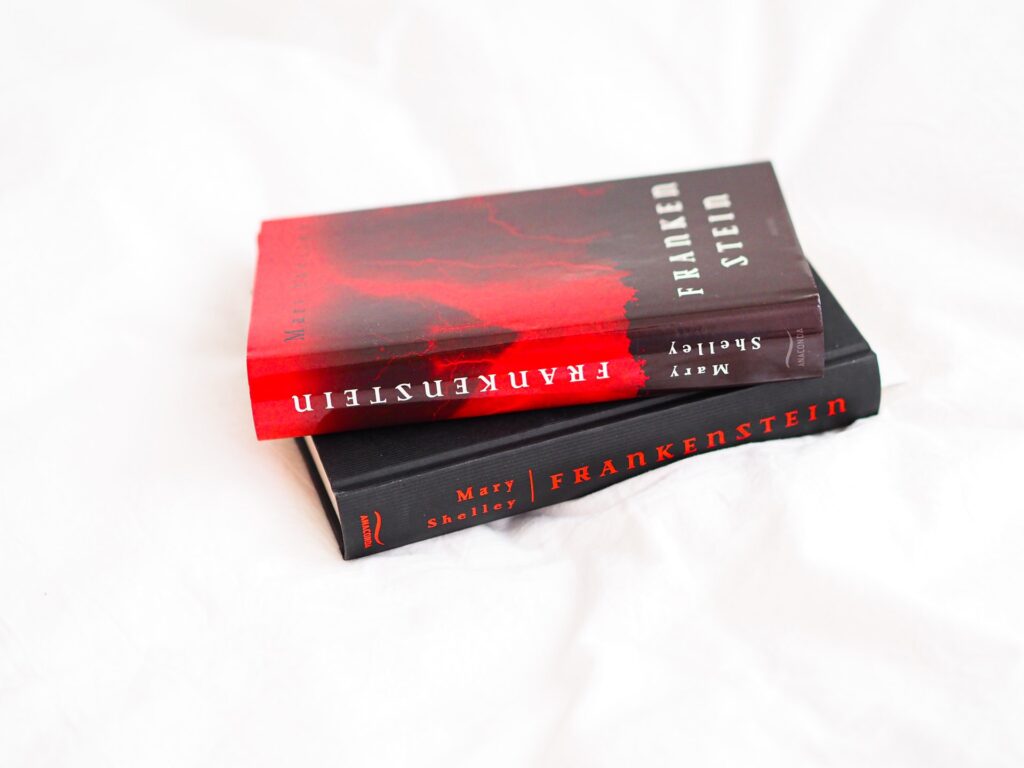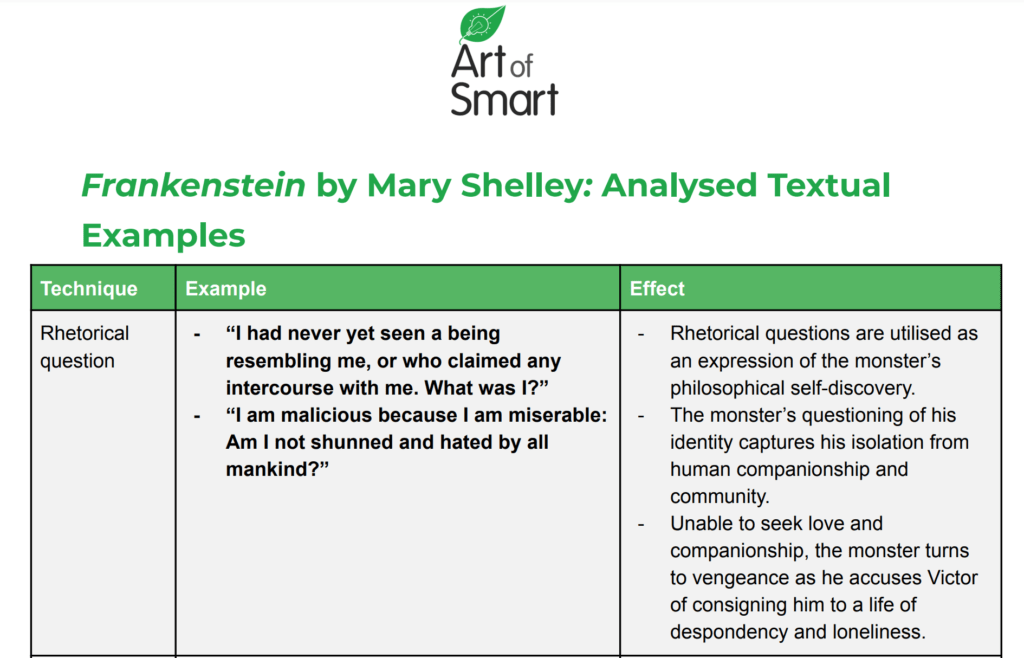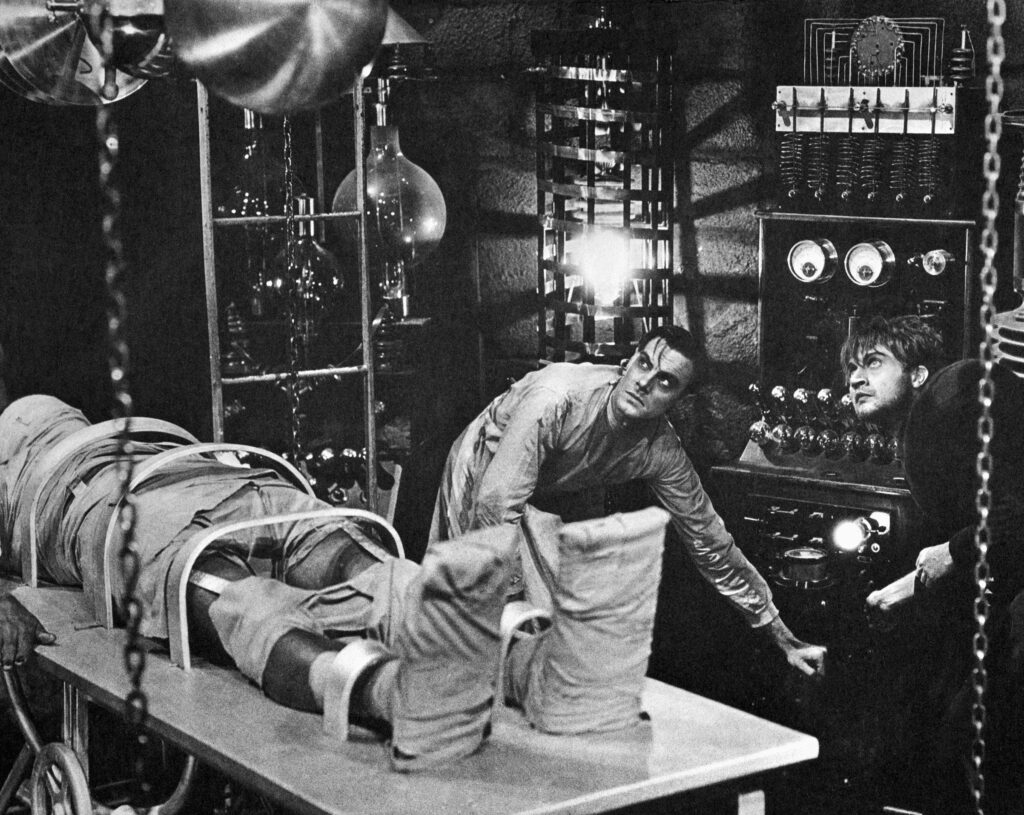Are you studying ‘Frankenstein’ for English but have no idea how to come up with an analysis for your essay? Look no further as we’ve got you covered with a summary of Frankenstein, and we’ll walk you through the key characters, context, themes and a step-by-step guide on how to perfect your analysis.
PLUS, we’ll provide you with a sample analysis table (also called a TEE table) and a sample paragraph for Frankenstein!
So, what are you waiting for? It’s time to ace your analysis of Frankenstein — let’s jump into it!
Frankenstein Summary
Key Characters in Frankenstein
Context
Themes Explored in Frankenstein
Essay Analysis of Frankenstein
Studying this Text for the HSC
Summary of Frankenstein
The text is told in an epistolary narrative form using three narrators: Robert Walton, Victor Frankenstein, and the monster. The novel begins with a series of letters by Walton, an arctic explorer, to his sister. He writes of his encounter with a weakened Victor on the ice, who he nurses back to health aboard ship.
Victor’s Perspective
The narration shifts to Victor as he begins his tale, beginning with his nurturing and idyllic childhood with Elizabeth Lavenza, his adopted sister, and Henry Clerval, his best friend. Victor attends the university of Ingolstadt where he becomes engrossed in natural philosophy and chemistry and isolate himself from his family.
He becomes consumed with the pursuit of scientific knowledge and decides to create human life by fashioning the body from corpses. After bringing the monster to life, Victor is horrified by the sight of him and runs away, falling into a hysterical fever after the monster’s disappearance.
After his recovery, Victor prepares to return home to Geneva when he receives a letter from his father telling him that his youngest brother, William, has been murdered. On his way to his family house, Victor sees the gigantic figure of the monster lurking in the woods and is certain that he is William’s murderer.
He soon discovers that Justine Moritz, the family’s trusted servant, has been accused of William’s murder and is executed after her trial. Victor becomes tortured by grief and escapes to the Alpine valley of Chamonix. The monster approaches him and eloquently proclaims that he is intrinsically benevolent but turned cruel due to his suffering.
The Monster’s Perspective
The narration turns to the monster’s perspective as he recounts the beginning of his life and his refuge at the cottage of the De Lacey’s. Seeking love and companionship, the monster yearns to learn their language and gains knowledge by reading books, learning of his creation by reading Victor’s laboratory journal.
After summoning the courage to speak to the cottagers, he is rejected and violently beaten, forcing him to flee. The monster becomes possessed by revenge and travels to Geneva to find Victor, strangling William after he screamed in terror.
The monster ends his tale by begging Victor to create a female monster for him to have as a companion.
Back to Victor’s Perspective
Victor resumes his narration and initially refuses but eventually agrees. Victor and Henry travel to Scotland, where Victor isolates himself to work on creating his second monster.
One night, Victor is horrified to see the monster grinning at him through the window and destroys the half-finished creation. Furious, the monster vows that he will be with Victor on his wedding night.
Later that night, Victor disposes of the remains out at sea and is drifted into dangerous waters, but he manages to land safely near an unknown town. Upon arrival, he is arrested for the murder of Henry, who has been strangled to death by the monster. Victor suffers a feverish illness in prison before being cleared of all criminal charges.
Victor returns home to Geneva with his father and marries Elizabeth. Fearing the monster’s threat, Victor sends Elizabeth away to her bedroom, yet he hears her scream and realises his fatal mistake. Soon after Victor’s father dies of grief, he resolves to devote his life to the creature’s destruction.
Victor tracks the monster on the ice and chases after him with his dogsled, but the ice breaks and Victor is set adrift. He is near death before Walton’s ship appears and saves him.
Walton’s Letters
The end of the story is told through Walton’s letters, where it’s learned that Victor has died. Soon after, Walton discovers the monster weeping over Victor’s body, who asks him for forgiveness.
He tells Walton of his suffering and vows to kill himself, disappearing out into the ice.
Key Characters in Frankenstein
Victor Frankenstein
The main narrator of the text, Victor, is responsible for creating and abandoning the monster. In contrast with his happy childhood, Victor’s obsession with scientific pursuit leads him to overstep natural boundaries and results in his family and friends’ tragic loss of lives.
The monster
A gigantic hideous creature formed from dead body parts; the monster is Victor’s abandoned creation who was thrust into the unknown world.
The monster is inherently good and seeks acceptance from society, but his constant rejection and hostility from humans drives him to take revenge on Victor.
Robert Walton
Opening and closing ‘Frankenstein’, Walton is an arctic explorer who records the tales of Victor and the monster in a series of letters to his sister.
Elizabeth Lavenza
Elizabeth is Victor’s adopted sister and wife, described as a caring young woman who is wholly devoted to Victor. She is murdered by the monster on their honeymoon.
Henry Clerval
Victor’s best friend and intellectual foil, Henry supports Victor in his times of need and nurses him back to health. The monster kills him after Victor destroys the second monster.
Context of Frankenstein
Frankenstein is set during the 18th century and engages with many of the important ideas and thinkers of the Romantic period. This literary and philosophical period was marked by political, economic, scientific, and social enlightenment that emphasised reason and individualism.
How Frankenstein Came to Be
Considered one of the first science-fiction novels, Mary Shelley’s Frankenstein began as a simple ghost story.
In 1816, the revolutionary lyrical poet Percy Bysshe Shelley travelled with his wife Mary to visit his friend Lord Byron in Switzerland. Due to the constant rain that kept them indoors, Byron suggested a ghost story contest to entertain themselves.
Based on a nightmare, Mary’s story won the contest, and she was encouraged to turn it into a full-length novel, which she did.
The daughter of the radical feminist Mary Wollstonecraft and radical philosopher William Godwin, Mary’s writing was heavily influenced by her parent’s writing and exposure to revolutionary thinkers. Frankenstein draws upon various philosophical ideas about childhood development, identity, and education, notably through the works of Jean-Jacques Rosseau and John Locke.
Other Influences
The prominence of scientific rationalism in Frankenstein was influenced by Luigi Galvani’s reanimation of dead tissue by applying electricity to a dead frog. Shaped by contemporary developments in scientific progress and discovery, Frankenstein serves as a cautionary tale for relying on scientific education divorced from moral values.
Frankenstein also draws upon the ideals of the Romantic Movement and the French Revolution during the 18th and 19th centuries. Victor’s creation of the monster implies defiance towards religion and a push towards enlightenment and rationality.
The novel is linked to two creation texts: the Greek myth of Prometheus and the Biblical creation story recounted in Milton’s ‘Paradise Lost’.
Image sourced from BBC Science Focus Magazine
Themes Explored in Frankenstein
As a novel, several structural, contextual, and literary elements aid in deconstructing the major themes of the text.
In Frankenstein, the use of multiple narrators, foreshadowing, symbolism, intertextuality, and allusions create parallels and connections to fundamental ideas of significant social and political upheaval.
Below are some of the key themes from Frankenstein that make for a strong starting point to structure your essay analysis:
- Pursuit of knowledge
- Sublime nature
- Responsibility
- Alienation
- Revenge
How to Analyse Frankenstein in 3 Steps for Your Essay
Students often try to start with their thesis while attempting to answer an essay question. Instead, you should use your analysis as the starting point!
Analysing your text is a great way to gain an in-depth understanding of its meaning before you begin to answer anything about it.
After you’ve analysed your text, you will be able to build on its themes and construct a strong thesis!
We’re going to walk you through creating an essay analysis for Frankenstein in three simple steps!
Step 1: Choose your example
When choosing your example, a pro tip is to search for an excerpt that contains a technique. Techniques are the key to helping you dig deeper into what meaning the composer is trying to convey.
We have chosen to look at two quotes that compare Victor to God:
“Wretched devil! You reproach me with your creation, come on, then, that I may extinguish the spark which I so negligently bestowed.”
and
“Remember, that I am thy creature: I ought to be thy Adam, but I am rather the fallen angel, whom thou drivest from joy for no misdeed.”
Step 2: Identify your technique(s)
When trying to locate a technique within your example, the best method is to identify a technique that enables you to uncover a deeper subtext of your work and elevate your argument and analysis.
Rather than referencing simple language techniques like alliteration and rhyme, try searching for techniques that unveil symbolic meanings like metaphors, motifs, allusions, and intertextuality.
We have identified three techniques in the two quotes above for our Frankenstein essay analysis: allusion, symbolism and metaphor.
It’s always better to try and find multiple techniques in your quotes rather than just one, so you can really show off your analysis skills!
Step 3: Write the analysis
When you write your analysis, the key focus should be on what effect the technique has. Simply labelling what technique you’re using is not analysing and will award you minimal marks.
Technique labelling would look like this:
The allusion of Victor to Prometheus and God is shown through Victor’s threat to “extinguish the spark” as symbolic of Prometheus’s forbidden power and the metaphor of the monster as “the fallen angel” as a reference to Milton’s ‘Paradise Lost’.
Instead of labelling, we need to flesh out how each technique allows a closer reading of the text.
Firstly, the allusions are important as they provide a familiar narrative in which we can view the characterisation of Victor as God and the monster as his creation.
The symbolism of Victor’s threat to ‘extinguish the spark which I so negligently bestowed’ is important because it parallels Prometheus as a representation of a figure that disrupts the natural order.
The metaphor of the monster as “the fallen angel” is significant because it alludes to Milton’s ‘Paradise Lost’ and suggests that Victor has failed in his moral duty and responsibility as the creator.
So if we included all that in our analysis, it looks like:
Victor’s characterisation as God serves as an allusion to the creation texts of the Prometheus myth and the Biblical creation story referenced in Milton’s ‘Paradise Lost’. Victor’s threat to “extinguish the spark which I so negligently bestowed” parallels Prometheus and symbolises Victor’s challenging of the natural order and transgression of forbidden territory by playing God. The monster’s plea to Victor that “I ought to be thy Adam, but I am rather the fallen angel” is a metaphor that alludes to Adam’s lament to God referenced in Milton’s ‘Paradise Lost’. The monster’s likening to Adam prompts Victor to evaluate his moral duty and responsibility as the creator.
Studying this text for HSC Extension English
If you’re studying this text for the HSC Extension English, when writing an essay on Frankenstein, you’ll need to connect your ideas to the rubric. We’ve included the rubric below to refresh your memory!
Link #1: Seeking unity, certainty, solace, justice or restoration
The monster’s experience in Frankenstein is wholly based on his journey to seek unity, certainty, solace, justice and restoration. The monster begins his life seeking unity and companionship, with his pursuit for knowledge and humanity displaying his genuine desire to participate in society.
However, the hostile responses of individuals exemplify his rejection and isolation from society.
The monster’s inability to find acceptance fuels his desire for destructive justice against his creator to restore his world of upheaval.
Link #2: Represent shifting values, contexts and attitudes
Containing elements of Romanticism, Gothicism and Science Fiction, Frankenstein is a revolutionary novel that heavily draws upon the shifting values, contexts, and attitudes of society during the Age of Enlightenment. The novel reflects the growth of ideas centred on reason, progress, and liberty during a period of significant scientific and technological advancement.
Rather than simply celebrating these values, Shelley critically represents attitudes of concern towards rapid scientific development by warning of the danger of overstepping human potential.
Need some help analysing other texts?
Check out other texts we’ve created guides for below:
- Romeo and Juliet
- Lord of the Flies
- Little Miss Sunshine
- Hamlet
- Jane Eyre
- In Cold Blood
- Persepolis
- Amélie
- The Book Thief
- The Tempest
- Blade Runner
- Jasper Jones
Are you looking for some extra help with your essay analysis of Frankenstein?
We have an incredible team of tutors and mentors!
We can help you master your essay analysis of Frankenstein by taking you through the summary, context, key characters and themes. We’ll also help you ace your upcoming English assessments with personalised lessons conducted one-on-one in your home or online!
We’ve supported over 8,000 students over the last 11 years, and on average our students score mark improvements of over 20%!
To find out more and get started with an inspirational tutor and mentor, get in touch today or give us a ring on 1300 267 888!
Ashley Sullivan is a Content Writer for Art of Smart Education and is currently undertaking a double degree in Communications (Journalism) and a Bachelor of Laws at UTS. Ashley’s articles have been published in The Comma and Central News. She is a film, fashion and fiction enthusiast who enjoys learning about philosophy, psychology and unsolved mysteries in her spare time.








